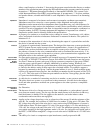
Glossary145
operators using Port Alpha setup In AZ™EDIT. (Click the “Port Alpha” button in AZ™EDIT,
then press F1 on the computer keyboard if you need help.)
Postproduction
Production activity that occurs after the actual production phase. For example the editing of a
television or motion picture production.
Postproduction
Editing
The process of making decisions and actually manipulating the media (film or tape) to change
action sequences, delete, insert, and modify images and sound.
Pot
(Potentiometer)
A device to electrically change audio or video levels. Potting up means increasing a level from a
control panel. An audio mixing console is an audio control panel.
Power Amplifier
An amplifier used for driving lower impedance (8 to 500 ohms) headphones or speakers (2 to 45
ohms).
Power Supply
1) The source of electrical power (“power outlet”). In North America this source is generally 120
volts AC, 60 hertz. In Japan the source is generally 100 volts, 50 or 60 hertz. In Britain the source
is 240 volts, 50 hertz. In Europe the power is usually 220 volts, 50 hertz. There are exceptions in
every location, and there are still isolated odd systems throughout the world. RTS™ Systems
equipment has been designed to operate at these various voltages. In addition, some equipment is
operable off of DC sources such as batteries, automobile 12 volt power, aircraft 28 volts, and
aircraft 120 volts, 400 hertz. 2) A unit used for converting power outlet power to DC power.
Power Supply,
TW
A special power supply to run user stations on the RTS™ Systems TW system. This supply
provides low noise DC power (nominally 32 VDC) and an audio impedance of 200 or 400 ohms.
This impedance extends from 100 hertz to 20000 hertz.
Power Ratio
See decibel.
Preamplifier
An amplifier usually used to raise the small signal from a microphone to a “line level” sized
signal.
Presence Peak
A rise in the response of a microphone in the range of 2000 to 10, 000 hertz. In circuits, a
deliberate alteration of the frequency response in the range of 1000 to 10,000 hertz. RTS™
Systems Model 802 has a small presence boost in the speaker amplifier change in the 1000 to
2000 hertz range.
Pressure Zone
Microphone
(PZM)
Used to pick up audiences or groups. A microphone with a reflecting surface such that the sound
waves arrive in phase at the microphone element, providing good frequency response. Also used
for orchestral pickup.
Program,
Program Audio
In television, the audio signal that is being sent out with the picture to be broadcast.
Push- To- Talk
(PTT)
Usually used on handsets or push-to-talk microphones. Pushing the button enables the
microphone and often also enables an electronic switch in an intercom station. The electronic
switch prevents amplifier and cable pickup from going on the intercom line as undesired noise.
Q
R
R
Abbreviation for resistance, and the symbol for a resistor.
Rack Unit(s)
(RU)
A standard unit of measure used when dealing with electronic equipment racks. 1 RU = 1.75”
(44.45 mm). For example: a particular piece of equipment is described as being 3 RU in height.
This means that it is 5.25” (3 x 1.75”) in height. Detailed information on the specification of
standard electronic equipment racks can be found in EIA RS-310-D (See the references section).
Reactance
A property of an inductor or capacitor that is frequency dependent. Capacitive Reactance is
opposite to Inductive Reactance. Inductive reactance increases with frequency. Capacitive
reactance decreases with frequency. See Capacitance and Inductance.
Relay
Relay is used interchangeable with GPI output. The relay feature works with the 16 GPI outputs
of an optional UIO-256 Universal Input / Output Frame, and with the relay outputs of an FR9528


















